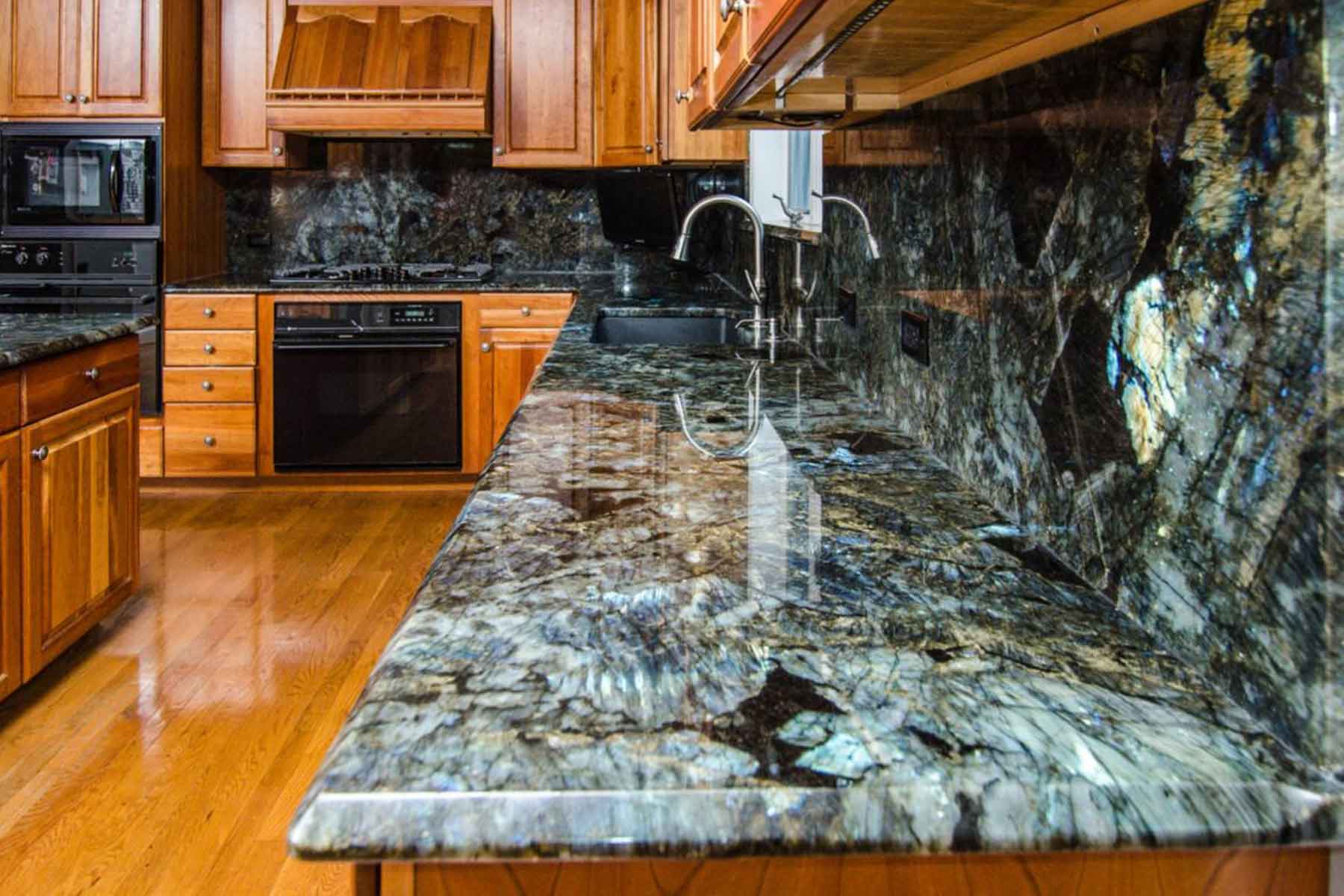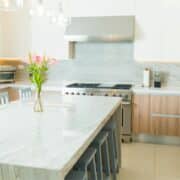Labradorite countertops are an exquisite addition to any home, offering a touch of elegance and sophistication that is unmatched by other materials. Known for their distinctive beauty, labradorite slabs boast an iridescent play of colors that seem to dance beneath the surface. In this article, we’ll delve into the origins of this unique stone, explore its properties, and discuss the benefits of choosing labradorite for your countertop.

I. Origins of Labradorite
Labradorite is a type of feldspar mineral that was first discovered in the late 18th century on the Labrador Peninsula in Canada, from which it gets its name. It is also found in various other locations around the world, including Madagascar, Finland, and Ukraine. This semi-precious gemstone is known for its stunning optical phenomenon, called labradorescence, which causes a striking display of iridescent colors to appear as light hits the stone at different angles.

II. Properties of Labradorite
Labradorite is a relatively hard and durable stone, with a Mohs hardness rating of 6 to 6.5. This makes it suitable for use in countertops, where it can withstand everyday wear and tear. However, it is still essential to take appropriate care when using labradorite in your home, as it is not as resistant to scratching and chipping as materials like granite or quartz.
The colors displayed in labradorite slabs can range from blue, green, and yellow to orange, red, and even violet. This incredible spectrum of colors is caused by the interference of light within the stone’s unique crystal structure, which gives labradorite its characteristic labradorescence. Each slab of labradorite is unique, ensuring that your countertop will be a one-of-a-kind centerpiece in your home.
III. Benefits of Labradorite Countertops

Aesthetic Appeal
The most obvious advantage of choosing a labradorite countertop is its unparalleled beauty. The shimmering colors and intriguing patterns found in each slab create a captivating focal point for any kitchen or bathroom. The iridescent effect adds depth and dimension to the stone, making it an ideal choice for homeowners looking for a unique and eye-catching countertop material.
Durability
As mentioned earlier, labradorite is a fairly durable stone with a Mohs hardness rating of 6 to 6.5. While it is not as resistant to scratching and chipping as some other countertop materials, it can still withstand the rigors of everyday use when properly cared for. Its durability means that your labradorite countertop should last for many years without losing its luster or beauty.
Heat Resistance
Labradorite is a naturally heat-resistant material, making it an excellent choice for use in kitchens where hot pots and pans may be placed directly on the countertop surface. However, it is still a good idea to use trivets or heat pads to avoid potential damage or discoloration of the stone.
Low Maintenance
Labradorite countertops are relatively low maintenance compared to other natural stones like marble or limestone. They do not require frequent sealing, as they are less porous and less susceptible to staining. However, it is still important to clean up spills promptly to prevent any potential damage to the stone. Regular cleaning with a mild soap and water solution is typically all that is needed to keep your labradorite countertop looking its best.
Unique and Customizable
Since each labradorite slab is distinct, homeowners have the opportunity to choose a countertop that reflects their personal style and taste. The wide range of colors and patterns ensures that there is a perfect slab for every design aesthetic, from traditional to contemporary. Additionally, labradorite can be cut and polished in various ways, allowing for customization in terms of edge profiles and other design elements.
Things to Consider When Choosing a Labradorite Countertop
Cost
The cost typically ranges from around $70 to $200 per square foot, depending on factors like the quality of the stone, installation complexity, and location.
High-grade labradorite with vibrant colors and consistent patterns will be on the higher end of the price spectrum, while options with less clarity or color may be more affordable. This makes labradorite significantly more expensive than standard options like granite or quartz, which generally range from $50 to $100 per square foot.
Proper Installation
Due to the weight and nature of labradorite slabs, it is crucial to work with experienced professionals for the installation of your countertop. Proper support and installation techniques are necessary to ensure that your labradorite countertop is secure and long-lasting.
Care and Maintenance
As mentioned earlier, labradorite countertops require minimal maintenance compared to other natural stones. However, it is still essential to take proper care of your countertop to maintain its beauty and longevity. This includes regular cleaning with mild soap and water, promptly addressing spills, and using trivets or heat pads to protect the surface from extreme temperatures.
Frequently Asked Questions
Is labradorite suitable for outdoor use?
While labradorite is a durable and heat-resistant material, it is not recommended for outdoor use due to its susceptibility to weathering and fading. Prolonged exposure to direct sunlight, moisture, and temperature fluctuations can cause the stone’s colors to fade or the surface to become damaged.
How do I clean my countertop?
Cleaning a labradorite countertop is simple and straightforward. Use a soft cloth or sponge with mild soap and water to clean the surface. Avoid using harsh chemicals or abrasive cleaners, as they may damage the stone or its finish.
How often should I seal my labradorite countertop?
Labradorite is less porous than some other natural stones, so it does not require frequent sealing. However, it is a good idea to consult with your countertop provider or installer for specific recommendations regarding sealing frequency, as this can vary depending on the stone’s finish and individual characteristics.
Can I cut directly on my labradorite countertop?
While labradorite is a relatively hard and durable material, cutting directly on the surface is not recommended, as it can lead to scratches or damage. Instead, always use a cutting board to protect the countertop and maintain its beauty.
Are labradorite countertops prone to chipping or cracking?
Although labradorite is a durable material, it is not completely immune to chipping or cracking. These issues can arise if the countertop is not properly supported, installed, or cared for. To minimize the risk of damage, ensure that your labradorite countertop is installed by experienced professionals and follow appropriate care and maintenance practices.
Can labradorite countertops stain?
Labradorite is less porous than some other natural stones, making it less susceptible to staining. However, it is still important to clean up spills promptly and avoid exposing the stone to harsh chemicals or highly acidic substances that may cause staining or damage.

Labradorite countertops are known for their rare beauty and striking colors. They are a popular choice for homeowners who want to make a statement in their kitchen or bathroom. With proper care, labradorite can last a long time and stay stunning. While it may cost more than some other materials, its unique look and strength make it a good investment for those who want both style and practicality.








